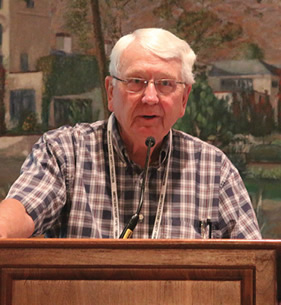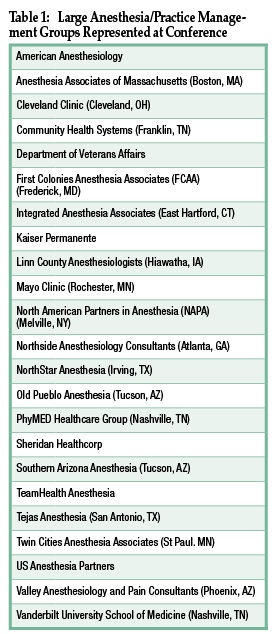
Dr. Robert Stoelting, moderating.


Dr. Robert Stoelting, moderating.

On September 10, 2015, APSF invited representatives of large anesthesia and practice management groups to meet with members of the APSF executive committee to discuss mutually relevant anesthesia patient safety issues. The goal was to help APSF identify and implement patient safety initiatives of particular interest and value to the conference participants. Thirty-six attendees representing 23 large anesthesia/practice management groups participated in the half-day session (Table 1). These 23 groups represented a wide geographical cross-section of the United States and a variety of practice models that included all categories of anesthesia professionals. The American Society of Anesthesiologists, which has a committee on Large Group Practice, was represented by Daniel J. Cole, MD, President Elect, and Paul Pomerantz, CEO. As an introduction to the conference, Robert K. Stoelting, MD, APSF President, reviewed past, current, and possible future APSF patient initiatives and provided “his view” of the three options available for APSF recommendations to become “best practices.”
One option is for professional associations (ASA, AANA, AAAA) to adopt APSF recommendations in the form of policy statements (Standards, Practice Advisories) that would be applicable to all association members. The reality of this option is unlikely considering the widely diverse opinions and practice profiles of the members of these organizations.
The second option for APSF recommendations to become “best practices” is “spreading the word” among individual anesthesia professionals via educational materials (such as conference reports in the APSF Newsletter) or educational videos. Although the written word is the traditional approach, APSF also believes educational videos provide a robust model that could be more powerful than a written report for effecting change.
The third option for effecting change and the principal reason to involve large anesthesia groups and practice management groups is APSF’s hope that these entities would individually endorse and adopt selected APSF recommendations that are relevant to their practices, needs and resources.
Following these introductory comments, the attendees met in three breakout groups with members of the APSF Executive Committee to consider three questions (see below) with the goal of creating a report to present to the conference’s general session. Bullet points following the questions represent conclusions/recommendations from each of the three breakout groups and the number in parentheses represents the number of times this statement appeared independently in each group.
1. In your practice, what do you consider to be the most important safety issues in terms of potential harm to patients?
2. Please describe how APSF can best partner with “your practice” to advocate patient safety initiatives.
3. APSF has a specific interest in the “simulation component” of MOCA based on the belief that simulation provides “practice for managing rare emergencies.” Do you believe a requirement for simulation based on “practice for rare emergencies” would bring value to members of your group?
In addition to the breakout group reports, the results of a Pre-conference Survey that had been sent to attendees prior to the conference (29 out of a possible 36 surveys were returned) were presented to the attendees (bullet points represent survey responses).
1. In your practice, what do you consider to be the most important patient safety issues in terms of potential harm to patients? (responses in order of frequency)
2. Please rank the importance of APSF safety initiatives in your practice. APSF safety initiatives that were viewed as “high priority for my practice” were:
3. Please describe how APSF can best partner with “your practice” to advocate patient safety initiatives.
4. Do you perceive a downside/risk for your anesthesia group partnering with APSF to incorporate specific safety initiatives? An example would be requiring “advanced medical technology training” paralleling the published APSF recommendations.
Yes (3) No (25)
5. APSF has a specific interest in the “simulation component” of MOCA based on the belief that simulation provides “practice for managing rare emergencies.” Do you believe a requirement for simulation based on “practice for rare emergencies” would bring value to members of your group?
Yes (23) No (4)
Based on the breakout group recommendations and the survey responses, it is concluded that high priority safety issues viewed as placing patients at risk for harm were (1) distractions in the operating room, (2) production pressures, and (3) communication issues. Medication safety, technology training, monitoring postoperative respiratory depression and monitoring neuromuscular blockade were also mentioned as safety concerns.
Overall, the attendees seemed to endorse a role for APSF in advocating best practices based on safety initiatives with reservations related to evidence to support the recommendations and cost of implementing these changes. There was agreement that simulation for “practice for managing rare emergencies” had merit, but logistics and cost were problematic.
APSF will consider the conclusions and recommendations of this conference for implementing “best practices” on a broader scale than “one anesthesia professional at a time” and for establishing priorities for future safety initiatives. APSF believes that large anesthesia/practice management groups offer an opportunity for an ongoing partnership with APSF as we pursue our mutual vision that “no patient shall be harmed by anesthesia.”
Robert K. Stoelting, MD President, APSF